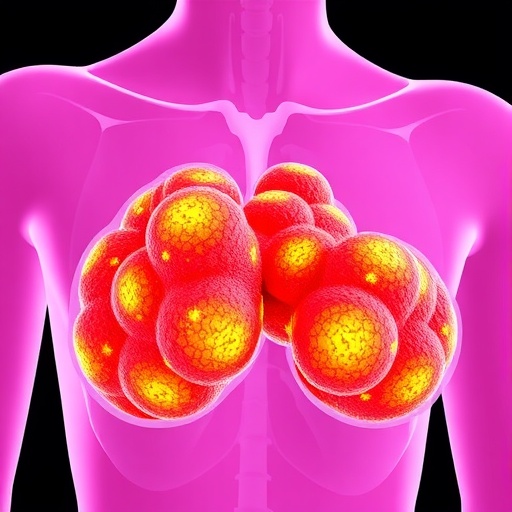In a groundbreaking study poised to reshape breast cancer treatment paradigms, researchers have unveiled the critical role of cancer-associated fibroblasts (CAFs) in driving radiotherapy resistance. Published in BMC Cancer, this integrative analysis dives deep into the tumor microenvironment (TME), revealing how specific CAF subtypes sculpt immune landscapes that undermine therapeutic success. The findings not only enhance our molecular understanding of breast cancer biology but also present novel avenues for targeted interventions designed to improve patient outcomes.
Breast cancer remains one of the most prevalent malignancies globally, with radiotherapy being a cornerstone of treatment strategies. However, resistance to radiotherapy poses a persistent clinical challenge, often leading to disease recurrence and poor prognosis. This study, leveraging the latest single-cell RNA sequencing technology, dissects the heterogeneity within CAF populations, a cell type historically overshadowed but increasingly recognized for its influential role in cancer progression and immune modulation.
The research identifies three principal subpopulations of CAFs in breast cancer tissues, most notably inflammatory CAFs (iCAFs) and matrix-modulating CAFs (mmCAFs). These distinct groups were enriched in cells positively linked to patient prognosis, as flagged by the innovative Scissor⁺ analysis method. This approach enabled the pinpointing of CAF subsets with the highest relevance to clinical outcomes, underscoring their potential as biomarkers and therapeutic targets.
Characteristically, the iCAFs and mmCAFs demonstrated elevated stemness—a property associated with cellular plasticity and aggressive tumor behavior. Importantly, these subtypes appear to orchestrate immune evasion by interacting with epithelial and immune cells in the TME. Their activities facilitate immune rejection mechanisms that compromise CD8⁺ T-cell responses, thereby suppressing the body’s natural anti-tumor immunity and fostering an environment conducive to tumor survival and growth.
Leveraging the transcriptomic data of these CAFs, the team constructed a gene signature that stratified breast cancer patients into distinct molecular clusters reflective of their tumor immune milieu. High-risk clusters exhibited a dense stromal framework, dampened cytotoxic T-cell functions, and activation of immunosuppressive pathways, such as those mediated by vascular endothelial growth factor (VEGF). This complex interplay creates a fortress shielding cancer cells from radiotherapy-induced damage.
The clinical implications of this gene signature were profound. It served as a robust predictive tool for identifying patients at elevated risk of radiotherapy resistance, validated rigorously across large cohorts from the METABRIC and GEO datasets. Such validation strengthens the potential utility of this signature in real-world settings, offering clinicians a precision medicine tool to tailor treatment plans effectively.
One of the most compelling aspects of the study involved the development of a five-gene CAF risk model that distilled complex molecular insights into an accessible prognostic instrument. This model consistently predicted poor survival outcomes and radiotherapy resistance, offering a crucial early warning system for clinical decision-making. Among these genes, ENO1 emerged prominently, correlating strongly with TP53 mutations — a hallmark of genomic instability and aggressive disease.
The association between ENO1 expression, TP53 mutation status, and resistance phenotypes paints a compelling picture of the molecular orchestration underlying treatment failure. It suggests that targeting the pathways regulated by such risk genes could disrupt the protective niche CAFs create, thereby sensitizing tumors to radiotherapy and improving therapeutic efficacy.
These insights place CAFs at the heart of tumor-stroma crosstalk, redefining them as not mere bystanders but active architects of a hostile microenvironment. Their role extends beyond structural remodeling to dynamic immune regulation and direct influence on therapeutic outcomes, positioning them as critical nodes for intervention.
The authors highlight the potential of therapeutically targeting CAF subtypes or their signaling pathways to overcome resistance mechanisms. Such strategies may complement existing treatments, paving the way for combination therapies that more effectively dismantle the tumor’s defense systems and restore immune competence.
Importantly, this study exemplifies the power of integrating multi-omics data, single-cell transcriptomics, and advanced computational tools to unravel tumor complexity. It sets a precedent for future research aiming to decode the multifaceted interactions within the TME that dictate cancer behavior and treatment responses.
Looking ahead, translating these findings into clinical practice will require the development of diagnostic assays for CAF-derived gene signatures and the design of targeted agents to modulate CAF activity. Early-phase clinical trials focusing on such interventions could potentially revolutionize radiotherapy outcomes for breast cancer patients.
Moreover, this research enhances our conceptual framework of tumor biology by emphasizing stromal components, often overlooked in favor of tumor cells themselves, as pivotal determinants of therapeutic success or failure. The growing recognition of CAFs’ influence reinforces the need for a holistic approach to cancer treatment, integrating tumor cell intrinsic and extrinsic factors.
In summary, this integrative study enriches the narrative on breast cancer resistance to radiotherapy by elucidating the complex cellular and molecular tapestry orchestrated by CAFs. It opens promising new pathways for precision oncology—where deciphering the tumor milieu’s nuances guides tailored, more effective interventions and ultimately saves lives.
Subject of Research: The role of cancer-associated fibroblast (CAF) subtypes in radiotherapy resistance and tumor immune landscape remodeling in breast cancer.
Article Title: Integrative analysis identifies radiotherapy resistance-associated CAF subtypes shaping the tumor immune landscape in breast cancer.
Article References:
Li, Y., Zhang, Z., Liu, X. et al. Integrative analysis identifies radiotherapy resistance-associated CAF subtypes shaping the tumor immune landscape in breast cancer. BMC Cancer 25, 1603 (2025). https://doi.org/10.1186/s12885-025-15071-2
Image Credits: Scienmag.com




